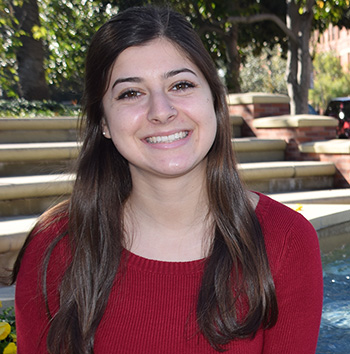
Maetal Haas-Kogan
When Maetal Haas-Kogan was just a few months old, her great-grandfather Benjamin Oudkerk gave his testimony to USC Shoah Foundation. Now, she’s a Harvard freshman and spending half of her winter break interning in USC Shoah Foundation’s education department.
Haas-Kogan said she grew up hearing stories about her family’s survival of the Holocaust. Her great-grandfather had survived the war mostly hiding in the home of friends who were also part of the resistance underground movement, and adopted her grandfather as a young boy after the war.
“Hearing their stories really influenced my values and everything I believed and how I saw the world and approached different problems,” Haas-Kogan said. “The idea of giving testimony and telling your story is really important, so I wanted to come and spend some time here and see all the amazing work [the Institute] does.”
She initially sent letters to managing director Kim Simon and director of administration Ari Zev explaining her connection to the Visual History Archive and why she wanted spend time at the Institute in any possible way – and was surprised and thrilled to receive a call back from senior program writer Aaron Zarrow to set up the internship.
For two and a half weeks during her winter break from Harvard, Haas-Kogan is working with the education department, selecting new clips for the IWitness “Watch” page, data coding teacher evaluations of Echoes and Reflections, and more.
It’s been inspiring for her to read teachers’ comments about how impactful education programs like Echoes and Reflections are for them and their students. And in watching so many testimonies in order to choose testimony clips for IWitness, she has noticed how survivors’ experiences intersect and differ from each other.
“For example, a lot of people experienced Kristallnacht, but all their experiences are so different, and yet each one is just as powerful,” she said. “Being able to see all their testimonies side-by-side, all their different experiences with the same tragic event, is really eye-opening.”
The Visual History Archive has also given her deeper connection to other genocides including the Rwandan Tutsi Genocide and the Armenian Genocide, and shown her the power of testimony to personalize events of the past. She was especially moved by something a World War II veteran said in his testimony: that the experiences he spoke of were memories for him, but merely history for other people.
“That quote really spoke to me on a personal level,” Haas-Kogan said. “Seeing these testimonies doesn’t [necessarily] make it a memory, but it goes from history in a textbook to a more real understanding of what these people were going through.”